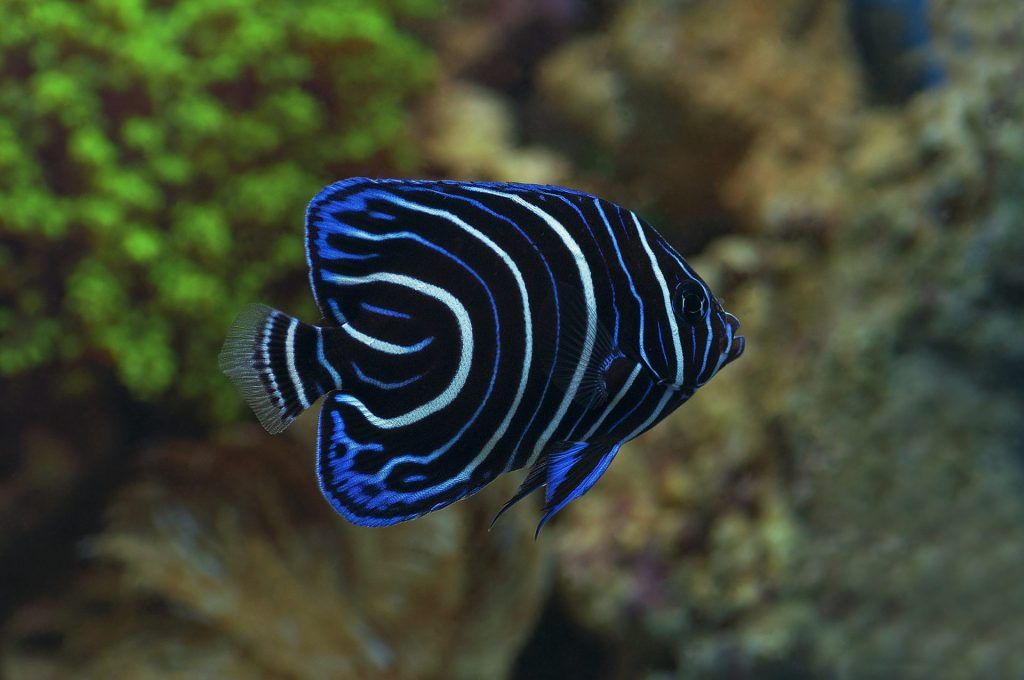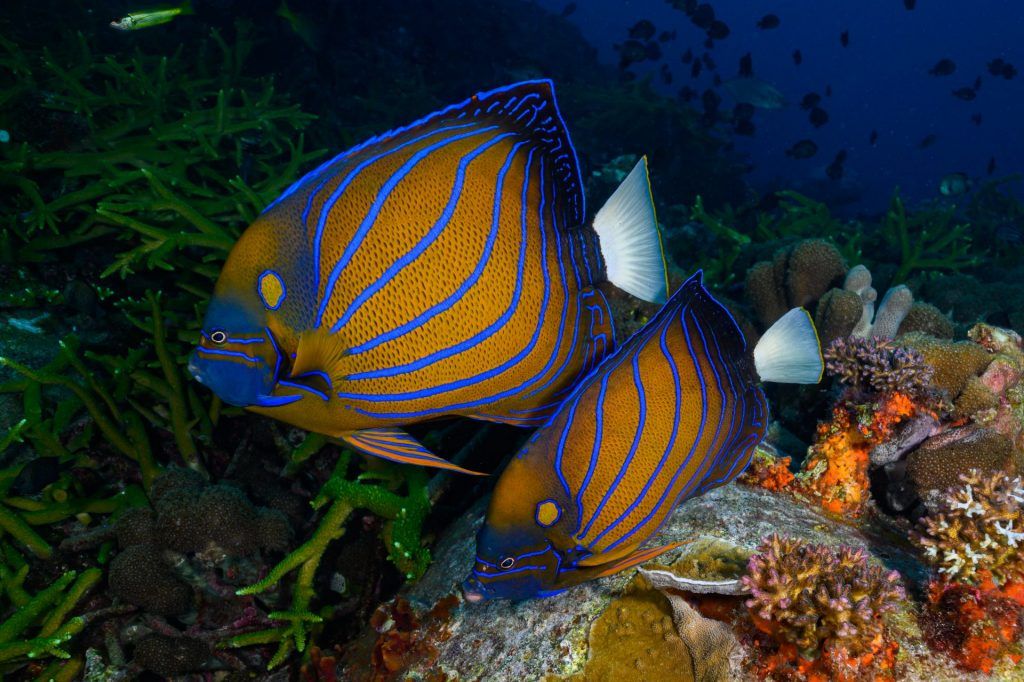Do you enjoy learning about saltwater fish? Does your saltwater aquarium need some extra “wow”? Or are you on the hunt for the rarest and most colorful fish that will make your tank the talk of the town?
Maybe you’ve heard of the blue ring angelfish.
Other common names for them are the Annularis Angelfish or the Blue King Angelfish. Whatever name you prefer, this fish belongs to the Pomacanthus genus, along with other awesome marine angelfish.
But what exactly is the blue ring angelfish?
Before we dive into the details of caring for one or what they look like, I have a question:
Do you have a large enough tank for this fish?
Some blue ring angelfish can grow up to 18 inches in length, although most stay closer to 14 inches. Fully grown, they will need an aquarium of at least 220 gallons or bigger to swim comfortably. Smaller adults or juveniles will be more than happy with less space than that, but you always need to prepare for their full size.
You’re not alone if you don’t have a tank that big. But…
If you do have a jumbo size tank, or you’re just fascinated by amazing marine animals like we are, keep reading!
Where Do Blue Ring Angelfish Come From?
The Indo-West Pacific region is home to many angelfish, including the blue ring angelfish. They are found in many places, from East Africa to New Guinea and New Caledonia, as well as southern Japan to Australia.
It’s a pretty big range, and even though they are documented in these waters, they aren’t always easy to find.
They like to stay around rocky coral reefs, caves, and even shipwrecks, between 3 to 30 meters deep. Blue ring angels are also more commonly found in the coastal waters of Indonesia and the Philippines compared to other places.
The blue ring angelfish is not a very common fish in the aquarium trade.
They are considered hard to collect and transport. This doesn’t mean you can’t find one, but they can be pretty expensive compared to other angelfish.
Besides their stunning colors and patterns, I’m sure this is a big reason they are sought after.
So if you get your hands on one of these beauties, you just might be one of the coolest fish in the sea!
What Do Blue Ring Angelfish Look Like?
Blue ring angelfish have a stunning appearance you’ll never forget. And if that wasn’t going to be enough, their colors and patterns go through some wild changes as they mature.
Juveniles have thin white to light-blue curved lines on a blue-black body.

Juvenile blue ring angelfish coloration and pattern
Adults have yellow bodies with bright neon blue lines arcing from bottom to top and a blue circle mark over their gills. They also sport a pair of blue stripes across the face, one running through the eye and the other below it. Their caudal fin is white with a yellow edge, and the dorsal fin often has an elongated tip.
Some blue ring angelfish can grow up to 18 inches in length, making them one of the largest angelfish in the world.
The gray angelfish (the largest angelfish) can reach up to 24 inches, but the blue ring is still an extremely large and impressive angel. Most angelfish species max out around 8-12 inches.
Getting back to the blue ring angelfish, they also have a compressed oval-shaped body with a small mouth and large eyes. Complete with 13 spines and 20 to 21 soft rays in the dorsal fin and 3 spines and 20 soft rays in the anal fin.
Not all fish change in appearance as they grow up, but when you have one like the blue ring angelfish that changes from a dark and mysterious juvenile to a bright and cheerful adult; it’s always fascinating!
How Does the Blue Ring Angelfish Behave?
Blue ring angelfish are semi-aggressive fish that can be territorial and dominant in the aquarium.
It’s best to keep an angelfish of this size in a large tank, at least 220 gallons, with plenty of hiding places like caves and overhangs. Live rock is a must, they will graze on algae all the time.
As a general rule, they shouldn’t be kept with other large or aggressive angelfish, especially those of the same genus, like an emperor angelfish. Which is another highly popular angelfish.

You do have more leeway with cohabitating when you have truly massive aquariums like 1,000 gallons or more. But most of us don’t have something that big. That doesn’t stop me from dreaming about one, though.
The best tankmates are peaceful fish or moderately aggressive fish that aren’t too small or too similar in shape and/or color.
Blue ring angelfish are protogynous hermaphrodites, meaning they start their life as a female and can change into a male later on. Like many marine fish species, they live in harems, where there is one male leader and several females.
When breeding, the male and female perform a courtship dance or ritual, circling each other and rising toward the water’s surface. At the end of the dance, they’ll release eggs and sperm into the water column. The eggs are pelagic (float in the open sea) and will hatch into planktonic larvae that drift in the currents until settling on the reef.
Caring for a Blue Ring Angelfish
Blue ring angelfish are an intermediate-level fish. Requiring some extra care and maintenance compared to, let’s say, a three-stripe damsel.
So it should come as no surprise they need good water quality and stable parameters. Water temperature between 72 to 78°F, pH at 8.1 to 8.4, specific gravity (salinity) around 1.020 to 1.025, and a hardness between 8 to 12 dKH.
They also need strong filtration, water movement, oxygenation, and regular water changes to stay healthy.
Blue ring angelfish are prone to some the more common diseases, such as ich, marine velvet, bacterial infections, and parasitic infestations.
Treatments like copper-based medications and a few other remedies are readily available, but prevention is always better than cure.
To avoid stress and prevent disease, there are a few simple tips.
- Acclimate your new fish properly.
- Quarantine new arrivals.
- Avoid overcrowding.
- Provide enough space and hiding places.
- Monitor water quality.
Don’t worry; it’s not as hard as it sounds. It takes some extra effort, but having a healthy and happy blue ring angelfish is worth it!
What do Blue Ring Angelfish Eat?
Like other angelfish, the blue ring is an omnivore that feeds on zooplankton, sponges, filamentous algae, tunicates, and other benthic (bottom dwelling) invertebrates in the wild.
In captivity, they need a similar diet that includes both meat and vegetation.
It’s best to offer them frozen or live foods like mysis shrimp, brine shrimp, krill, squid, clam, or bloodworms.
You can also feed dried or flake foods that contain spirulina, algae, or sponge matter. Really it’s a matter of personal preference. I prefer to feed fresh foods whenever possible, but there’s nothing wrong with either way.
Try to switch it up too! Offer different foods on different days to give them a well-rounded diet.
Offering a variety of different foods can also alleviate boredom and improve the coloring and condition of your fish. The little bit of extra effort definitely has some solid benefits for you and your fish.
They will also graze often on algae in the aquarium, which will supplement their dietary needs as well.
Feed your blue ring angelfish twice a day. A good rule of thumb is to feed no more than what will be eaten in 2 minutes.
Overfeeding or underfeeding leads to health problems or nutritional deficiencies.
Is the Blue Ring Angelfish a Good Idea for Your Aquarium?
Again a matter of personal preference, I say Yes! Blue ring angelfish are magnificent fish that will add some bright colors and personality to your aquarium.
Their dramatic changes in appearance and behavior throughout their life is also fascinating to watch if you happen to get a young one.
Keep in mind, the blue ring angelfish is not a great fish for beginners or for small tanks.
They need a large tank with ample space and hiding places, as well as good water quality and compatibile tank mates.
If you have the ability to meet their needs, the blue ring angelfish is a rewarding and fascinating fish to keep.
Great tankmates for a Blue Ring Angelfish
If you’re looking for ideas on other fish to keep with your blue ring angelfish, here are some solid choices:
- Flame Angelfish
- Clownfish
- Purple Tang
- Blue Green Chromis
- Benggai Cardinal
- Sailfin Tang
- Cleaner Wrasse
This is by no means a complete list, but hopefully, it gets you started in your search for blue ring angelfish tank mates!
























